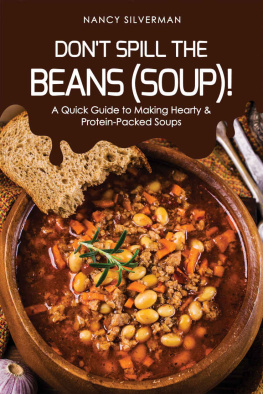ACKNOWLEDGMENTS

My research for this book took me all over Italy. Both old friends and acquaintances and many people I did not know before shared their knowledge, their cooking techniques, their food, and their homes with me. With their considerable help, I was able to pursue the bean trail from Lecce to Bra, from Naples to Udine, and from San Remo to Ancona. And I was as surprised and delighted by the regional diversity of bean dishes that still exists in Italy today as I was refreshed by the overwhelming generosity I encountered everywhere I went.
In Italy, I owe special thanks to those who guided, fed, and informed me: Bean growers Mario Agostinelli in Regello and Enzo Pistelli and his family in Terni showed me bean cultivation firsthand; Lori DeMori in Florence shared her intimate knowledge of the local cuisine; restaurateurs Rino and Guia Krcivoj in Tricesimo, Romano Tamani in Quistello, Matteo and Christina Ascheri in Bra, Paolo and Barbara Massieri in San Remo, and Rino and Lucia Botte in Barile all prepared special regional bean dishes for me and shared their recipes; Francesco and Giovanella Giavazzi provided me with sources and stories; Alberto and Susan Alesina rescued vital source material for me; Baronessa Cecelia Bellelli Baratta in Capaccio graciously shared her home and recipes; Rosella Speranza arranged an engaging and enlightening tour of Puglia; Bianca Tragni in Altamura added insight into the culinary history of Puglia; Domenico Maggi interpreted the contemporary culinary practices of Puglia; Costanza La Grua in Leece opened her kitchen and shared her table with me; Simona Cardone in Bari was an eloquent and tireless translator; and Iris Carulli introduced me to the food markets of Rome.
Closer to home, I am first and foremost indebted to my friends, Ann Berman and Sam Spektor, for their generosity and hospitality, and for eagerly sharing their knowledge and enthusiasm for the cuisine of Italy with me. Arthur Schwartz generously included me in his cooking school's itinerary and imparted his ebullience and understanding of the foods and culture of southern Italy. Franco and Gwen Romagnoli shared their recipes with me. I was also provided assistance and advice from Nancy Civetta, Corby Kummer, Rene Becker, and Elizabeth Constanza. My sister, Jane Silver, was a tireless traveling companion and supporter. And I owe countless thanks to Noelle Blanchard for tasting and testing recipes, and even more for her warm friendship.
This project couldn't have happened without my agent, Jane Dystel, whose skill and insight were essential in bringing this book into being. And I am indebted to my editors at Rodale, who have all been enthusiastic and creative.
And finally, I owe immeasurable appreciation to my husband David and daughters Annie and Rachel for their unwavering enthusiasm, support, and encouragement, their eagerness to accompany me on my eating adventures, and their willingness to eat whatever I cook.
Electronic edition produced by

www.antrikexpress.com
ABOUT THE AUTHOR

JUDITH BARRETT is a food writer and the author of five previous cookbooks. Her most recent, Saved by Soup, was nominated for both a James Beard and an International Association of Culinary Professionals book award. She is also coauthor of the best-selling Risotto. She lives in Cambridge, Massachusetts.
Conversion Chart
These equivalents have been slightly rounded to make measuring easier.







FAGIOLI

The Bean Cuisine of Italy
As central as fagioli (beans) are to the cuisine of Italy, the delights of Italian been cookery are virtually unknown to the American palate. Now author Judith Barrett sets us on the savory course to making up for lost time. Here in this definitive compendiumthe only cookbook devoted solely to the glories of Italian bean cuisineyou'll find more than 120 easy-to-prepare, authentic favorites featuring fagioli, including antipasti and salads, soups and stews, polentas and pastas, and a wide range of meat, poultry, and seafood dishes.
"It's time for everyone to fall in love with fagioli," writes Barrett. With these marvelous recipes, that love affair is about to begin.
Discover the delights of fagioli in all their delicious variety and versatility. Fogioli, the first cookbook devoted to the bean cuisine of Italy, takes you on a savory journey to the best minestrone you've ever tasted and far beyondfrom the earthy comfort of Piemontese Braised Veal with Borlotti and Vegetables to the elegant simplicity of Salad of White Beans, Shrimp, and Tomato. You're sure to fall in love with fagioli at every stop along the way.
Along with these inspiring recipes comes all the essential know-how:
- Handy charts for calculating cooking times and substituting American equivalents for Italian beans
- A chapter explaining various specialty ingredients and listing sources for purchasing them via mail order and the Internet
- A full-color photographic key identifying various Italian beans
Antipasti APPETIZERS
APPETIZERS
Crostini di fagioli bianchi
WHITE BEAN SPREAD FOR CROSTINI
This versatile bean spread can be prepared well ahead of time, even a day or two. Remove the spread from the refrigerator an hour before you plan to serve it. Always serve at room temperature.
I like to accompany it with thinly sliced, crusty bread, crostini, that may be toasted or served fresh. You can improvise with this recipe and add more garlic or lemon juice or even some fresh parsley chopped in with the beans. Because the consistency of cooked beans varies, you can add some additional olive oil if the spread seems too thick or dry.
1 CUP DRIED WHITE BEANS, SUCH AS CANNELLINI OR GREAT NORTHERN, OR 2 CUPS COOKED WHITE BEANS, DRAINED SALT
1 CLOVE GARLIC, OR MORE TO TASTE, PEELED JUICE OF LEMON
CUP EXTRA VIRGIN OLIVE OIL, PLUS MORE FOR SERVING
FRESHLY GROUND BLACK PEPPER
1 LOAF FRENCH-STYLE BAGUETTE, SLICED INTO -INCH-THICK SLICES, OR OTHER COUNTRY BREAD, CUT INTO SMALL SERVING-SIZE PIECES
If you are using dried beans, soak them in cold water for 8 hours or longer. Drain and discard the soaking water. Rinse under cold water and drain again. Combine the beans with 6 cups cold water in a medium saucepan over medium-high heat. When the water begins to boil, lower the heat and simmer, uncovered, about 1 hour, until the beans are tender. Season with salt, turn off the heat, and allow to cool to room temperature. Drain.



















